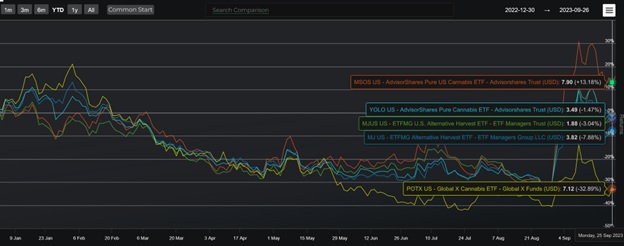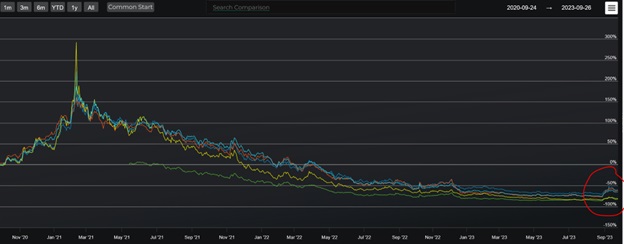Like any recovering reporter, I like to keep tabs on my old beats, and the marijuana ETF space never disappoints. Or, perhaps more accurately, it never stops disappointing.
That’s because, as an investment theme, marijuana has provided investors more hype and hope than return. For years, market observers have predicted cannabis was on the cusp of becoming a $100 billion industry. Yet in 2022, the U.S. cannabis industry was worth only $13 billion, with the rosiest estimates of cannabis sales reaching $34 billion by the end of 2023. (Compare that to, say, tobacco, whose revenues surpassed $82 billion in 2022.)
Disappointment perpetuates. Cannabis is legal for medical and/or recreational use in 39 states, at the federal level. But the drug is as much under lock and key as it ever was.
As a result, every congressional memo or procedural vote is enough to whipsaw markets — including this week’s reports of a new marijuana banking bill advancing for consideration to the Senate floor.
Has anything really changed? Sure. Slightly. Very slightly. But we’ve heard this song and dance before, so pardon me if I remain skeptical.
Rescheduling Talk, Federal Bill Push Marijuana ETFs Higher YTD
Eagle-eyed readers might have noticed that for the past several weeks, most of the top-performing U.S.-listed ETFs have been marijuana funds.
Over the past month, the AdvisorShares Pure Cannabis ETF (YOLO) is up 43%; the ETFMG U.S. Alternative Harvest ETF (MJ) is up 41%; and the Amplify Seymour Cannabis ETF (CNBS) is up 30%.
Read more: “Top Performing ETFs: Cannabis ETFs Ahead”
The surge began around August 30, when the Department of Health and Human Services recommended the Drug Enforcement Agency recategorize marijuana as a Schedule III drug, down from Schedule I. (More on why that matters in a minute.)
Though the top five marijuana ETFs have somewhat retraced the loftiest of their gains, they remain at relatively elevated levels year to date:

Year-to-date returns for the five largest marijuana ETFs. Source: LOGICLY
Pushing MSOS and other cannabis ETFs even higher this week was Wednesday’s news that the bipartisan Secure And Fair Enforcement Regulation Banking Act (or SAFER Banking Act) had advanced out of the Senate Banking Committee for consideration by the full Senate.
That’s optimistic news for cannabis stocks (and the ETFs holding them), because historically, the Senate is where federal cannabis legislation goes to die. The bill’s previous incarnation, the SAFE Banking Act, passed the U.S. House of Representatives seven separate times — but never once progressed far enough in the Senate to be considered by the full chamber.
On Wednesday morning, the share price of the AdvisorShares Pure U.S. Cannabis ETF (MSOS) rocketed so sharply that the NYSE placed a temporary trading halt on the security. (Shares continued trading after the halt. As of Thursday’s close, the ETF was up 2.2% for the week.)
Putting Cannabis ETF’s YTD Outperformance in Perspective
So yes, I agree: In the shortest term, the picture does look rosy. But if we zoom out the time scale to, say, the past three years, a much different story emerges.

See that red circle? We are here.
Source: LOGICLY. Data from Sept. 26, 2020 to Sept. 26, 2023
This week’s meteoric rise resolves into what it really is: a minor speed bump. On a three-year time frame, MJ is down 27%, YOLO is down 28%, and the Global X Cannabis ETF (POTX) is down 45%.
From a fundamentals perspective, there are plenty of reasons cannabis ETFs had such a rough three years:
- In a rising rate environment, growth-y small cap stocks have been particularly challenged; and marijuana companies are some of the smallest, growth-iest stocks around.
- While COVID-19 lockdowns, in which consumers were stuck at home with little entertainment, initially proved good for cannabis demand, persistent inflation has eroded consumer demand for discretionary items.
- Spreading state-level legalization has led to falling sales in individual local markets, due to reduced demand from out-of-state visitors.
- It has also led to an oversupply in cannabis inventory, as would-be producers rush to meet an expected demand surge and further depresses prices.
Then, of course, there’s a complex regulatory regime governing the cannabis industry, one where states operate according to different rules than the federal government.
In my opinion, even if the SAFER Banking Act miraculously becomes law and marijuana is rescheduled to Schedule III tomorrow, it still wouldn’t resolve the regulatory uncertainty looming over the industry like a storm cloud.
Why Marijuana’s Schedule Classification Matters for Investors
Currently, the Drug Enforcement Agency classifies cannabis as a “Schedule I” substance, subjecting it to the agency’s tightest controls. Schedule I drugs, like heroin, ecstasy, peyote, and cannabis, are prohibited from all usage cases federally; not even scientific researchers can easily gain access to the drugs.
Because of this classification, cannabis-related businesses may not access the federal banking system. This means they can’t accept credit cards, apply for small business loans, or even open bank accounts. All business operations must be conducted 100% in cash. This isn’t just a logistical nightmare but a significant security risk. It opens the business up to fraud, theft, and money laundering.
On top of that, marijuana companies are subject to tax code “280E“ (“Expenditures in connection with the sale of illegal drugs“). The law, which was designed to prevent drug dealers from claiming tax deductions on their operations, instead prevents legitimate marijuana businesses from deducting ordinary business expenses from their gross income. This includes advertising, salaries and wages, and more. By some estimates, many cannabis companies pay as much as 70% of their revenue in taxes.
And if that wasn’t enough, many big banks refuse to act as custodians for cannabis stocks. This means they hold them on behalf of investors, funds, and ETFs. No matter what laws local jurisdictions might pass, these institutions are beholden to federal banking laws, and holding stocks involved with a Schedule I drug could even cost them their FDIC insurance or banking license. (Hence why so much fuss resulted when ETF Managers Group circumvented its original bank custodian to in its launch of ETFMG Alternative Harvest ETF (MJ) back in 2017.) Without custodianship, investors will find it that much harder to invest — and marijuana companies will find it that much harder to raise the money they need to grow and scale.
Given all these restrictions, it’s kind of a miracle that the marijuana industry has grown as much as it has. No wonder so many think downgrading cannabis to a Schedule III would be a game-changer.
But I’m not convinced.
Rescheduling Marijuana Would Ease, Not Solve, Problems Facing Industry Growth
Don’t get me wrong: Rescheduling cannabis to Schedule III would have tremendous benefits for cannabis companies. With such a change, they’d be able to deduct business expenses, obtain loans, open bank accounts, and basically function like any other legitimate company in the U.S. It would stimulate business formation, improve cash flow, and mitigate much of the operational risk inherent in the cannabis trade.
Yet rescheduling is not the same as legalization or even decriminalization. Schedule III substances are still subject to hefty restrictions over commercial activity. Purchase and sale involves specific licensing, prescription, and reporting requirements, and shipping Schedule III substances via the postal system is still tightly controlled.
What’s more, if an individual state makes marijuana illegal within its borders, it’s still illegal, regardless if it’s an illegal Schedule I drug or an illegal Schedule III drug.
Therein lies the rub. All 50 states (and several territories) each have their own regulatory regime when it comes to marijuana usage, sale, cultivation, and possession. Rescheduling marijuana instead of de-scheduling it altogether (and legalizing it, like alcohol and tobacco) does nothing to resolve the discrepancies between individual states, or between state and federal law. In some ways, it complicates matters further: In some states where marijuana in any form is completely outlawed, like Idaho or Nebraska, it’s conceivable federal regulation would become more lax than state law.
For financial institutions thinking nationally rather than hyper-locally, that adds complexity to the regulatory picture rather than diffusing it. And if there’s anything big banks and other institutions hate more, it’s volatility in regulatory risk.
SAFER Banking Act Has Promise, But Many Roadblocks Ahead
But what about the SAFER Banking Act? Could this help remove some of the systemic regulatory issues facing the industry?
It sure would, assuming it could ever become law. In its current form, the bill would construct a financial infrastructure of support at the federal level for the cannabis industry. It would exempt banks from penalties when offering services to state- and local-level cannabis companies operating in accordance with state laws. This means they could offer bank accounts to cannabis companies, for starters. It would also prevent federal regulators from forcing banks and credit unions to close said accounts based on “reputational risk.” Instead, they’d need a good reason.
Making it out of committee is not the same thing as passage, however. Assuming this bill can ever get a full vote in the Senate, it will still need to pass muster in the House, and gain the president’s signature. A lot can change in a bill during reconciliation.
That’s if the bill even gets considered at all. Looming on the horizon is a federal government shutdown that would start on October 1. If that goes into effect, the SAFER Banking Act would enter a limbo state. With each passing day, it would fall lower on the docket of priorities waiting for when lawmakers return to work, until eventually its chances of consideration would evaporate entirely.
New Marijuana ETFs Still Coming to Market
Still, hope springs eternal, and even now, new cannabis ETFs are hitting the market. Earlier this month, Subversive Capital launched the Subversive Cannabis ETF (LGLZ), an actively managed fund investing in the global cannabis market. The managers select cannabis stocks based on strong operational cash flow, under the reasonable assumption that these companies would be best poised to capitalize on legalization if and when it occurs.
When I consider marijuana ETFs, however, I can’t help but see parallels in the bitcoin/blockchain space. So much hype, and so little to show for it.
I’m not saying there isn’t genuine investment opportunity in this space. But until the federal government gets out of the way once and for all, the cannabis industry — and cannabis ETFs — will never truly get off the ground.
For more news, information, and analysis, please visit VettaFi | ETF Trends.


